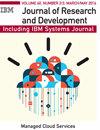IBM z15上的系统恢复增强
IF 1.3
4区 计算机科学
Q1 Computer Science
引用次数: 0
摘要
IBM z15服务器上的System Recovery Boost加速了计划中的操作系统关闭、计划中的或计划外的操作系统初始程序负载(IPL)、中间件和工作负载重启和恢复,以及随后的客户机工作负载执行,从而加速了停机前后的服务恢复。它通过提供持续时间有限的“提升周期”来实现这一点,提升周期提供了大量可用的额外处理器容量和并行性。在次容量机器模型上,它通过以全容量速度运行通用处理器来提高处理器速度,这只适用于增强lpar,并且只在增强期间。它使所有定义为增强图像的可用处理能力可用于处理任何类型的工作,在增强期间“模糊”了通用处理器和专用处理器的能力。System Recovery Boost还加速和并行处理器重新配置操作,这些操作可能是客户端整体重启和恢复过程的一部分,由地理分散并行系统(GDPS)自动化编排。System Recovery Boost还可以通过激活一种新的临时容量记录,从客户端未使用的“暗核”中添加额外的处理器容量。所有这些都可以在不增加客户机的IBM软件计费成本或在这些提升期间与客户机工作负载相关的处理器消耗的情况下完成。本文章由计算机程序翻译,如有差异,请以英文原文为准。
System Recovery Boost on IBM z15
System Recovery Boost on the IBM z15 server expedites planned operating system shutdown, either planned or unplanned operating system initial program load (IPL), middleware and workload restart and recovery, and the client workload execution that follows, to accelerate service restoration around downtime. It does this by providing limited-duration “boost periods” that deliver significant usable additional processor capacity and parallelism. On subcapacity machine models, it provides a boost in processor speed by running the general-purpose processors at full-capacity speed, for the boosting LPARs only, and only during the boost periods. It makes all available processing capacity defined to the boosting images available to process any kind of work, “blurring” general-purpose processor and specialty processor capacity together during the boost period. System Recovery Boost also expedites and parallelizes processor reconfiguration actions that may be part of the client's overall restart and recovery process, as orchestrated by Geographically Dispersed Parallel Sysplex (GDPS) automation. Optionally, System Recovery Boost provides the ability to add additional processor capacity from the client's unused “dark cores” via activation of a new type of temporary capacity record. All of this can be accomplished without increasing the client's IBM software billing costs or the processor consumption associated with the client's workload during these boost periods.
求助全文
通过发布文献求助,成功后即可免费获取论文全文。
去求助
来源期刊

IBM Journal of Research and Development
工程技术-计算机:硬件
自引率
0.00%
发文量
0
审稿时长
6-12 weeks
期刊介绍:
The IBM Journal of Research and Development is a peer-reviewed technical journal, published bimonthly, which features the work of authors in the science, technology and engineering of information systems. Papers are written for the worldwide scientific research and development community and knowledgeable professionals.
Submitted papers are welcome from the IBM technical community and from non-IBM authors on topics relevant to the scientific and technical content of the Journal.
 求助内容:
求助内容: 应助结果提醒方式:
应助结果提醒方式:


